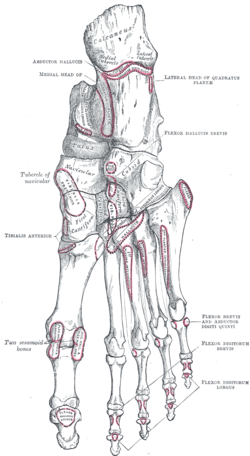Phalanges of the foot
It has been suggested that this article be merged into Phalanx bone. (Discuss) Proposed since December 2013. |
| phalanges of the foot | |
|---|---|
 Plan of ossification of the foot. | |
 Bones of the left foot. Plantar surface. | |
| Details | |
| Identifiers | |
| Latin | ossa digitorum pedis, phalanges digitorum pedis |
| Anatomical terms of bone | |
The phalanges of the foot are the bones in the toes. They correspond, in number and general arrangement, with those of the hand; there are two in the big toe, and three in each of the other toes. They differ from them, however, in their size, the bodies being much reduced in length, and, especially in the first row, laterally compressed.
- First row: The body of each is compressed from side to side, convex above, concave below. The base is concave; and the head presents a trochlear surface for articulation with the second phalanx.
- Second row: The phalanges of the second row are remarkably small and short, but rather broader than those of the first row.
The ungual phalanges, in form, resemble those of the fingers; but they are smaller and are flattened from above downward; each presents a broad base for articulation with the corresponding bone of the second row, and an expanded distal extremity for the support of the nail and end of the toe.
Articulations
In the second, third, fourth, and fifth toes the phalanges of the first row articulate behind with the metatarsal bones, and in front with the second phalanges, which in their turn articulate with the first and third: the ungual phalanges articulate with the second.
See also
Additional images
-
Foot bones - metatarsus and phalanges
-
Phalanges
-
X-ray of foot, showing phalangeal fractures
-
Skeleton of foot. Medial aspect.
-
Skeleton of foot. Lateral aspect.
-
Bones of foot
-
Knee, tibiofibular and ankle joints.Deep dissection. Anterolateral view.
![]() This article incorporates text in the public domain from the 20th edition of Gray's Anatomy (1918)
This article incorporates text in the public domain from the 20th edition of Gray's Anatomy (1918)





